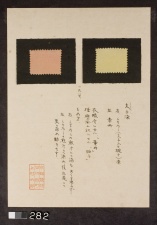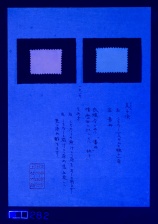Difference between revisions of "Kuchinashi + Beni - left (282 L)"
Jump to navigation
Jump to search
(username removed) |
(username removed) |
||
| Line 5: | Line 5: | ||
| 282 | | 282 | ||
|- | |- | ||
| − | ! scope="row"| | + | ! scope="row"|Uemura number / title |
| − | | | + | | ; "Haze-some 25" |
|- | |- | ||
! scope="row"|Folder location | ! scope="row"|Folder location | ||
| Line 41: | Line 41: | ||
| - | | - | ||
|- | |- | ||
| − | ! scope="row"| | + | ! scope="row"|Uemura's notes |
| − | | The fabric was soaked into 1) dye bath with of Kuchinashi; 2) dye bath of Benibana; and 3) vinegar. This color is supposed to be the " | + | | The fabric was soaked into 1) dye bath with of Kuchinashi; 2) dye bath of Benibana; and 3) vinegar. This color is supposed to be the "tan ()" in the Ebukuryo () from the 8th century AD, Japan., and "Kuchinashi ()" in the Harima fdo-ki (), 8th century. AD, Japan. |
|- | |- | ||
| − | ! scope="row"| | + | ! scope="row"|Uemura's date |
| Kyoto Murasakino | | Kyoto Murasakino | ||
|} | |} | ||
| − | [[Category: | + | [[Category:Uemura dye archive]] |
Latest revision as of 07:20, 24 July 2013
| Museum number | 282 |
|---|---|
| Uemura number / title | ; "Haze-some 25" |
| Folder location | 4th shelf |
| Sample location | left (282 L) |
| Fiber type | silk |
| Color | light pink (slightly orange) |
| Dyestuff (Japanese common name) | くちなし+紅 : Kuchinashi + Beni |
| Dyestuff (botanical name) | Gardenia jasminoides Ellis var. jasminoides; and Carthamus tinctorius L. |
| Plant part | K: fruit / dried; B: flower petal / dried |
| Dyestuff extraction | both boiled in water; note that Kuchinashi and Benibana baths were prepared separately. |
| Auxiliary agent in dye bath | - |
| Mordant | - |
| Other auxiliary agent | - |
| Uemura's notes | The fabric was soaked into 1) dye bath with of Kuchinashi; 2) dye bath of Benibana; and 3) vinegar. This color is supposed to be the "tan ()" in the Ebukuryo () from the 8th century AD, Japan., and "Kuchinashi ()" in the Harima fdo-ki (), 8th century. AD, Japan. |
| Uemura's date | Kyoto Murasakino |

